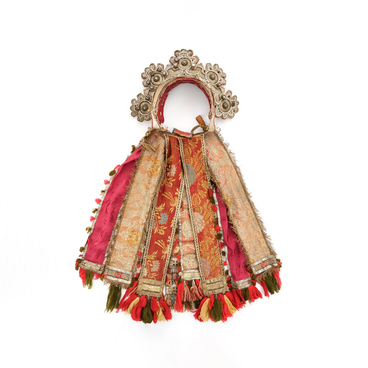Building her collection of “Russian Heritage”, Maria Klavdievna Tenisheva tried to cover all pages of the country’s history. So, among the numerous examples of silverware, she amassed a noteworthy collection of so-called “award kovsh vessels”.
A kovsh, or a ladle, is a Russian vessel for drinking and bottling home-brewed beer, kvass and honey. It was used in everyday life for several centuries. The main peculiarity of the traditional Russian ladle is its shape: an oblong body, with one of the handles made in the form of a bird’s head with a flat wide beak, and the other handle resembling a tail.
The ending of Russian fairy tales “I was there, drank mead and yet // Barely got my whiskers wet” is directly related to the ladle. In the 17th century, people began using small ladles with symmetrical flattened handles. Some researchers believe that they were to be held under the handles with both palms. Thus, this manner of drinking required slow movements, otherwise it would run down the mustache, but would not go into one’s mouth.
Kovsh drinking vessels were different in size and material. Ladles were made of wood, silver and even gold, decorated with carvings, paintings, and engravings. Some were inlaid with precious stones. From the mid-17th century, the Silver Chamber of the Moscow Kremlin began to produce ladles for awarding prominent people.
The kovsh presented in the Museum of Russian Heritage belonged to the so-called award ladles. It was presented by Peter III to the leader of the “Yaik army of the Zimoveyskaya stanitsa” Lazar Portnov “for his faithful and immaculate services.”
Peter III ruled for a very short time, just about six months, and was overthrown by his wife Catherine II. He died a week later under mysterious circumstances, which gave rise to a lot of rumors and led to the appearance of impostors.
Lazar Portnov’s fate brought him together with one of the impostors. In the spring of 1772, Portnov was the ataman of the Cossack team in the town of Iletsk and assisted the punitive military operation of General Magnus Ferdinand von Freymann (Fyodor Yuryevich Freymann) in suppressing the Yaik Cossack uprising.
Portnov also took a negative stance towards the uprising led by Pugachev, who called himself Peter III. Due to a lack of the necessary resources to fight, Portnov dispatched messengers to nearby fortresses and Orenburg in order to request military assistance. However, on September 21, 1773, Pugachev’s forces entered the town of Yaik and were enthusiastically welcomed by the local population. As a result, Portnov was captured and subsequently executed, while Pugachev adopted his son as a page. Ataman Lazar Portnov’s name is mentioned in Alexander Sergeyevich Pushkin’s “The History of Pugachev”.






